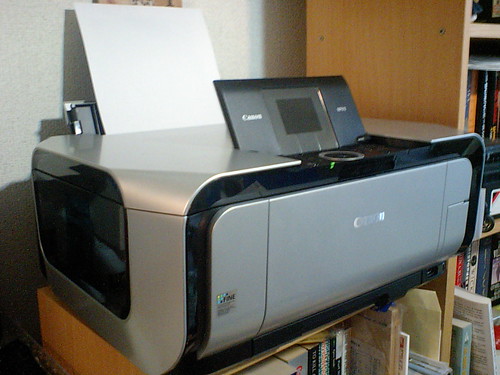Inkjet printers are great for low volume printing because the cost of the initial machine is low, and they have a small footprint. The printers aren’t as heavy as laser printers, nor does it take as long for the initial printing. Here are some facts about inkjet printers.

Source: MShades
- When you first purchase an inkjet printer, they come with starter cartridges that are filled only halfway. This practice is done for a number of reasons, primarily to keep ink from spilling during transport. This practice is also used to encourage you to purchase more proprietary inkjet cartridges. It is more cost efficient to purchase higher capacity cartridges for your use.
- The idea of inkjet printing has been present since the 19th century, but the technology wasn’t available until the 1950’s. Continuous inkjet printers were first used for medical strip chart recorders. The printers were first introduced by Siemens. In the 1970’s, inkjet printers for the consumer market were developed by companies like Epson, Lexmark, Hewlett Packard, and Canon.
- The process of continuous inkjet printing has not caught on in the personal inkjet printer market because the method itself uses a lot more ink than necessary. Commercial printers use that technology to print mark and code packages, as well as address direct mail pieces.
- The print heads for commercial inkjet continuous printers are further away from the paper, allowing businesses to print out banners, outdoor signs, billboards, and other large media. These printers can run up to $2 million in price, and can be up to 152 inches wide.
- Instead of a continuous inkjet process, most of the printers today (with the exception of Epsons) drop their ink on demand. Rather than continually running, the heads are given signals to make small droplets of toner onto the paper. Being such a precision process, the paper has to be extremely close to the printer heads so that miniscule amounts of ink can be applied to the paper.
- Inkjet ink is the most expensive liquid in the world. It is more valuable than gold, oil, or space shuttle fuel. The cost of manufacturing requires oil and other resources to be used for a precise mixture of chemicals that will adhere to the page.
- Inkjet printers are normally sold at near cost because the companies who make the printers also make the cartridges. Companies like HP, Lexmark, Epson, and Canon produce proprietary printers to sell proprietary ink at a high profit. This is in contrast to laser printer manufacturers which sell their printers at a premium.
- Personal use inkjet printers were brought to the market in 1984 with the introduction of the HP Thinkjet printer. This breakthrough device further cemented Hewlett Packard’s place on the global printer stage, increasing company revenues by 50%. The HP DeskJet inkjet printer is introduced in 1988, propelling it to the top 50 in the Fortune 500 listing at number 49. The DeskJet retailed for around $1000 each.
- The fastest inkjets in the world today are produced by RISO. Their ComColor 9050 model can produce up to 150 pages per minute in color. This is at least five times faster than home and small business printers which print between 15 and 30 pages per minute.
- Most of the parts within the inkjet printers can be recycled. All of the parts within the inkjet printer cartridges can be recycled, yet 70% of cartridges still end up in our country’s landfills. A modest estimate of the quantity of ink used today is 68 million gallons, enough to fill up 10 Olympic sized swimming pools.
Most home and small businesses possess inkjet printers to print document proofs, photos, and reports. Inkjet printers are here to stay.
James Adams, a UK based writer who wrote this guest post, works for Cartridge Save, a well know supplier of printer ink in the UK.
Nice facts…
thanks for sharing……
Glad that you like it 🙂
Nice overview –
some remarks:
the fastest inkjet printer is the HP T350 with about 4,000 pages per minute.
Epson is also using drop-on-demand printing, but the difference to most other SOHO offerings is that they use piezo technology.
Piezo is actually quite common in industrial and wide format printers.
Inkjet ink is only expensive when bought in small cartridges, in the litre tanks used for production systems prices it is more cost efficient than toner.
Hi,
I am glad that the blog owner has chosen a very interesting matter about inkjet printer. The main inkjet printer brands contain Dell, Lexmark, and Brother has relatively a few special models. The cartridges are not essentially compatible.I would like to congratulate for this hard work to the blog owner and would like to be part of this site by submitting comments.
Thanks for your interaction in comments.. would love to hear more comments 🙂
great facts man. really liked. most of the revenue is earned by cartridges, i agree totally.
nice fact to noticed great work
Very good informative information in this blog, so plz do blogging, keep it up.
lol, turned an extremely boring subject into a matter worth posting about 🙂 well done
Nice Review!
Ink jet printer is suitable for small business and home use as its initial cost is very low as compared to laser printers. I agree that most of the revenue us earned by selling cartridges.
Really appreciate your effort. Keep blogging!